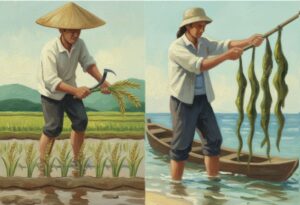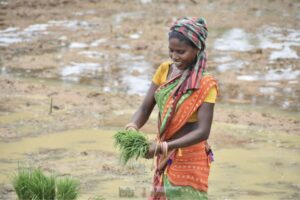
The International Rice Research Institute has had a longstanding relationship with Thailand. The first formal link was made in 1960—the year IRRI was established—when Thailand’s Prince Chakrabandhu became a founding member of the IRRI Board of Trustees.
Following this, in 1966, IRRI’s Thai office was established in Bangkok with the appointment of the first IRRI scientist assigned to Thailand. During that year, the IRRI variety IR8-288-3 was crossed with tall Thai rice cultivars to produce RD1 and RD3—the first nonglutinous, semidwarf, photoperiod-insensitive, high-yielding varieties released to farmers in the country. (See Breeding history on pages 34-38 of Rice Today Vol. 5, No. 4).
IRRI has maintained a close relationship with Thailand over the last 50 years and, within this period, four Thai scientists have worked at IRRI headquarters. Moreover, between 1966 and 2009, IRRI received 191 scholars from Thailand.
Thailand’s royal connection with IRRI has continued throughout the years. In July 1963, His Majesty King Bhumibol Adulyadej (Rama IX) visited IRRI to show his support for the fledgling institute and then, in 1996, he became the first and only Royal Patron of IRRI. Recently, in November 2009, Her Royal Highness Princess Maha Chakri Sirindhorn came to IRRI to launch the Institute’s 50th anniversary.
Rice in Thailand
 Rice is the most important crop of Thailand. It occupies about 55% of Thailand’s total arable land. Rice is also the staple food of all Thai people, regardless of income.
Rice is the most important crop of Thailand. It occupies about 55% of Thailand’s total arable land. Rice is also the staple food of all Thai people, regardless of income.
Thailand is the world’s biggest exporter of rice. In 2008, it exported about 10 million tons of rice (milled equivalent), which makes up about 33% of the world rice trade.
If there is anything this country is famous for, it is Thai jasmine rice, a high-quality, long-grain, aromatic white rice, which commands a price advantage over lower grades. According to the Board of Trade of Thailand, the biggest importers of Thai jasmine rice in 2009 were China, the U.S., and Malaysia. Countries such as Singapore, Japan, Nigeria, Senegal, and South Africa have all become major importers of Thailand’s many other grades of rice that include Pathumthani rice in whole grain and broken and white rice in parboiled, broken, and glutinous rice. Thailand’s rice products cross the wide spectrum of rice available for trade in the world. Interestingly, the country’s export rice prices are commonly considered to be the benchmark price for rice products from other nations.
Helping Thai rice production with IRRI science.
Some prime examples of IRRI’s research targeted at helping rice production in Thailand are pest management research, genetic diversity conservation, the Thai Rice Knowledge Bank, and growing rice in unfavorable environments.
Pest management.
Brown plant hoppers (BPH) are a major pest in rice fields. In the recent 2009-10 season, BPH have reached plague proportions in Thailand and may cause yield losses of up to 30% in affected paddies.
IRRI helps farmers manage pests in a sustainable way by developing pest-resistant rice varieties, integrated pest management (IPM) strategies, and ecological engineering approaches. IRRI has been monitoring the BPH and associated virus situations across Asia with increasing concern over the past several years.
In line with this, IRRI has recommended some practices to reduce the onset and severity of BPH outbreaks such as adopting IPM practices, limiting pesticide use, careful nutrient management, planting resistant varieties, synchronizing rice plantings, and encouraging beneficial insects.
For more information on managing BPH problems and preventing future BPH outbreaks, see An eco-smart solution against a swarm of destruction and visit the Ricehopper blog.
________________________________________________________________________________










